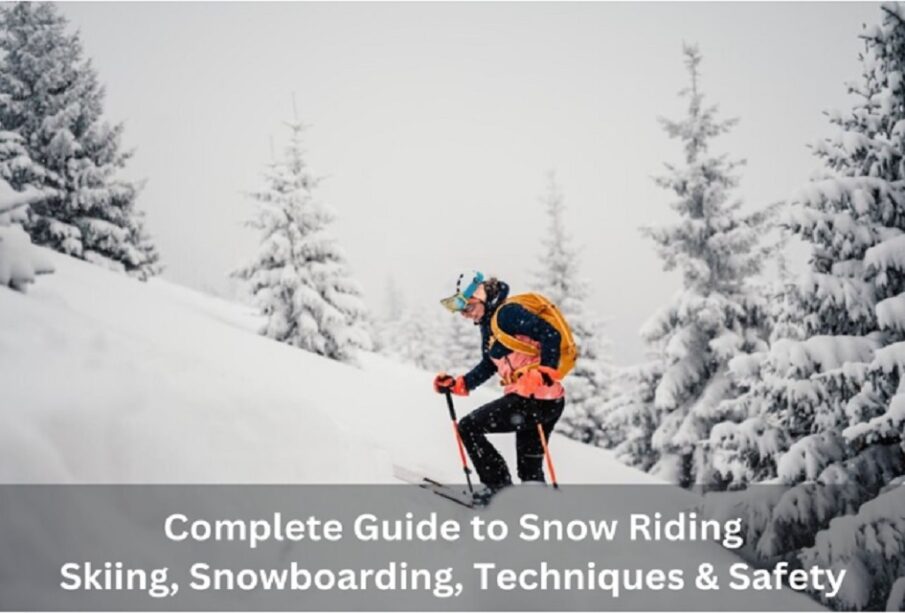Ultimate Guide To Snow Riding: Skiing, Snowboarding, Techniques & Safety

Snow riding, a thrilling winter sport that blends athleticism with the beauty of snowy landscapes, attracts adventurers and outdoor enthusiasts worldwide. Whether you’re drawn to the rush of skiing or the control of snowboarding, these activities offer unique experiences that cater to various skill levels and preferences. Here’s a comprehensive guide to snow riding, covering everything from equipment to techniques and safety tips.
Types Of Snow Riding
Skiing
Skiing involves sliding down slopes using two long, narrow pieces of equipment called skis. Skis are designed for speed, stability, and maneuverability. There are several styles of skiing:
- Alpine skiing: Known for its downhill racing and carving turns.
- Cross-country skiing: Involves skiing across flat terrain or gentle slopes, emphasizing endurance and navigation.
- Freestyle skiing: Focuses on acrobatic jumps, flips, and tricks in terrain parks.
Snowboarding
Snowboarding uses a single wide board attached to the rider’s feet, providing a different feel and technique compared to skiing. It’s popular for its freestyle elements, such as halfpipe tricks and rail slides, as well as its straightforward descent down slopes.
Essential Equipment
- Skis and Snowboards: Choosing the right skis or snowboard depends on your skill level, preferred terrain, and riding style. Beginners often benefit from all-mountain skis or snowboards, which offer versatility across various snow conditions.
- Boots: Ski boots and snowboard boots are specialized for each sport, providing ankle support and control. They should fit snugly for optimal performance and comfort.
- Bindings: Bindings secure your boots to the skis or snowboard, transferring your movements to the equipment. They come in various designs to suit different riding styles and skill levels.
- Helmet and Protective Gear: Safety is paramount in snow riding. A well-fitted helmet is essential to protect against head injuries. Additionally, wrist guards, knee pads, and impact shorts can reduce the risk of injury during falls.
Techniques & Tips
- Basic Techniques: Proper balance and posture are essential for safe and controlled snow riding. Maintain a centered stance with knees bent to absorb terrain variations effectively. When turning, skiers use their edges, while snowboarders rely on edge control techniques. Start with gradual turns to master technique before attempting sharper maneuvers and more challenging terrain. These fundamentals ensure stability and enhance the overall enjoyment of snow riding.
- Navigating Terrain: Understand the difficulty ratings of slopes (green for beginners, blue for intermediates, black for advanced), and gradually progress to more challenging terrain as your skills improve.
- Safety Considerations: Stay updated on weather forecasts to anticipate changes in visibility and snow conditions. Follow ski area rules by respecting signage, yielding to others, and avoiding closed trails or restricted areas. These practices ensure safety and enhance the enjoyment of snow riding for all participants.
Advanced Techniques
- Off-Piste Skiing/Snowboarding: For those interested in exploring beyond marked trails, understanding avalanche safety, terrain evaluation, and possibly carrying avalanche safety gear (like a beacon, probe, and shovel) is essential.
- Terrain Park Etiquette: If you’re into freestyle skiing or snowboarding, learn park etiquette, such as respecting others, waiting your turn for features, and starting with smaller jumps and features to build confidence.
Fitness & Readiness Prep
- Pre-season Conditioning: Strengthening leg muscles, core stability, and cardiovascular fitness before the season starts can improve endurance and reduce fatigue on the slopes.
- Rest and Recovery: Snow riding can be physically demanding. Adequate rest and recovery between sessions help prevent injuries and maintain performance.
Enjoying The Experience!
Snow riding isn’t just about speed and technique; it’s also about enjoying the natural beauty and camaraderie of winter sports. Many resorts offer après-ski activities like dining, spas, and nightlife, enhancing the overall experience beyond the slopes.
Conclusion
Snow riding offers an exhilarating way to embrace winter and explore breathtaking landscapes. Whether you prefer the precision of skiing or the freedom of snowboarding, mastering these sports requires practice, patience, and a commitment to safety. With the right equipment, techniques, and respect for the environment, you can unlock the joys of snow riding and create unforgettable memories in winter wonderlands around the globe.
FAQs
What should I wear for snow riding?
For snow riding, wear moisture-wicking base layers, insulating mid-layers, and a waterproof jacket and pants. Remember gloves or mittens, a snug hat or helmet, and goggles for wind and snow protection.
How do I choose the right skis or snowboard?
Consider your skill level, preferred terrain, and riding style. Beginners often start with all-mountain skis or snowboards that offer versatility across various snow conditions. Freestyle enthusiasts may opt for shorter skis or softer flex snowboards, while advanced riders might prefer specialized equipment tailored to specific disciplines like racing or powder riding.
What safety measures should I take while snow riding?
Always wear a helmet to protect against head injuries. Use wrist guards, knee pads, and impact shorts to reduce the risk of injury during falls. Stay aware of weather forecasts and snow conditions, follow trail markings and rules at ski resorts, and carry essential safety gear like a beacon, probe, and shovel if venturing off-piste.








